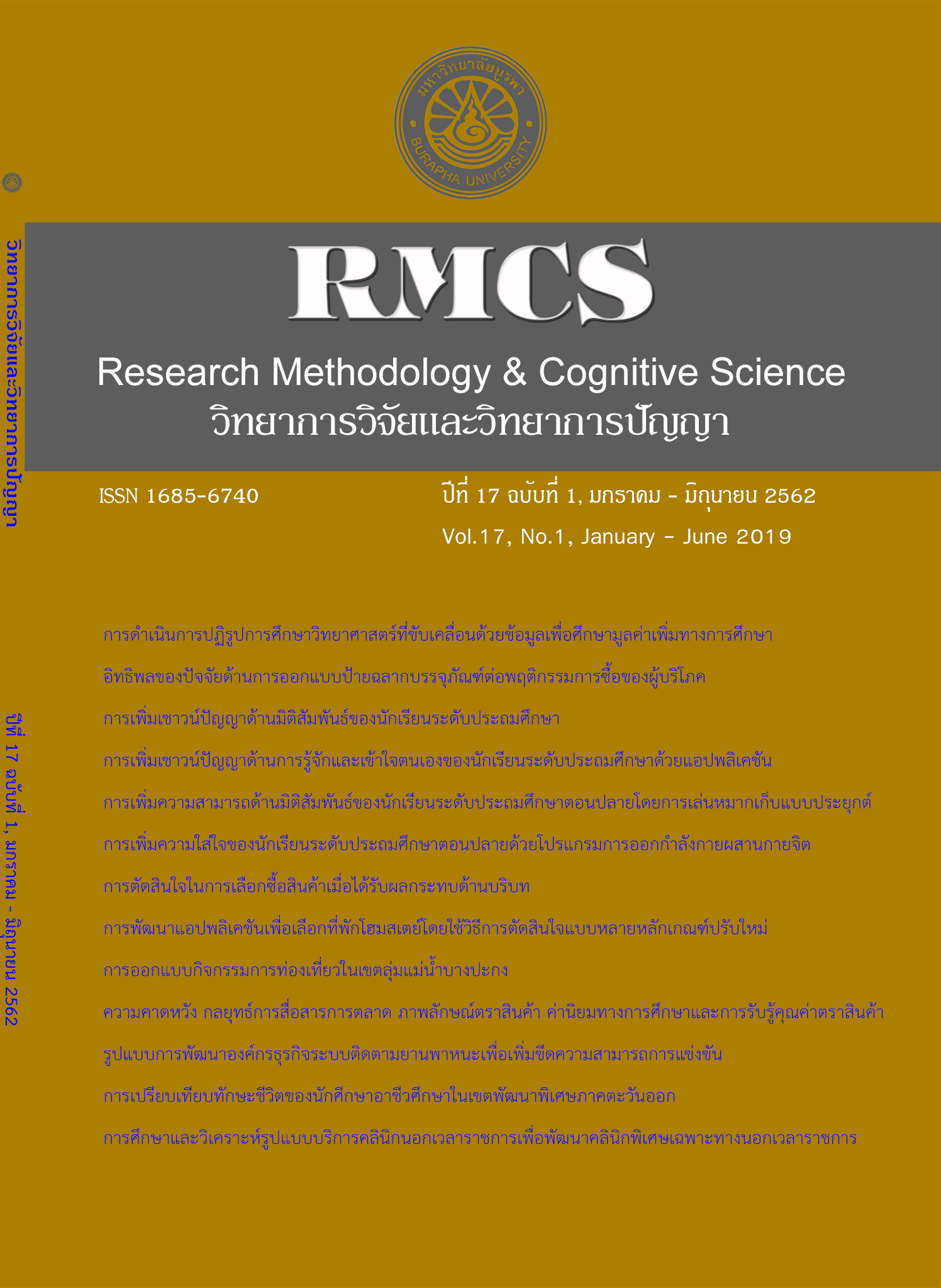Enhancing Attention in Upper Primary School Students Using Applied Mind-Body Exercise Program
Main Article Content
Abstract
The objectives of this research were to develop an applied mind–body exercise program using a stick, and to compare the accuracy of scores and response times on a selective attention task when given to an experimental group and a control group. Multi-stage random sampling was used to draw 90 primary school students in the second semester of the academic year 2017, Nikomsangtoneng Rayong 5 school, Nikhom Pattana district, Rayong. The experimental group received the new stick-based exercises while the control group undertook similar exercises without a stick. Data were analyzed by using descriptive statistics and t-tests.
Results indicated that:
1) The developed mind–body exercise program using the stick was composed of three main components: brain exercise, breathing, and meditation.
2) In the experimental group, after exercising the accuracy of scores and response times on the selective attention task were better than before exercising.
3) After both groups completed the exercises, the experimental group had higher scores on the attention task, and their response times were lower than those of the control group.
In conclusion, the developed mind–body, stick-based exercise program was found to enhance selective attention in upper primary school students.
Article Details
References
ดรุณวรรณ สุขสม และอาพรรณชนิต ศิริแพทย์. (2550). รายงานการวิจัยเรื่องการออกกำลังกายด้วยไม้ยืดหยุ่น: รูปแบบการออกกำลังกายทางเลือกสำหรับคนไทย. กรุงเทพฯ: สำนักกองทุนสนับสนุนการสร้างเสริมสุขภาพ.
ประภาพรรณ จูเจริญ. (2551). สมองวัยรุ่น. ใน: สายฤดี วรกิจโภคาทร, บัญญัติ ยงย่วน, สาวิตรี ทยานศิลป์,
บรรณาธิการ. หนังสือ 10 ปี ทศวรรษเพื่อเด็กและภูมิปัญญาของครอบครัว. กระบวนทัศน์ใหม่เพื่อพัฒนา
ศักยภาพเด็กไทยในทศวรรษหน้า. (หน้า 105-108). นครปฐม: สถาบันแห่งชาติเพื่อการพัฒนาเด็กและ
ครอบครัว มหาวิทยาลัยมหิดล.
พนิดา วิมานรัตน์. (2556). การเพิ่มการเลือกใส่ใจภาพและเสียงของนักเรียนโดยการออกกำลังกายแบบผสานกายจิตด้วยไม้พลอง: การศึกษาคลื่นไฟฟ้าสมอง. วิทยาการวิจัยและวิทยาการปัญญา, 11(1), 19-32.
วรพรรณ เสนาณรงค์. (2552). ออกกำลังกายสมอง ต้านอัลไซเมอร์. เข้าถึงได้จาก
https://www.kroobannok.com/blog/8087
Bailey, S. P., Hall, E. E., Folger, S. E., & Miller, P. C. (2008). Changes in EEG during graded exercise on a recumbent cycle ergometer. Journal of Sports Science & Medicine, 7(4), 505-511.
Bidzan-Bluma, I., & Lipowska, M. (2018). Physical activity and cognitive functioning of children: A systematic review. International Journal of Environmental Research and Public Health, 15(4), 1-13.
Christensen, L. B., Johnson, B., & Turner, L. A. (2011). Research methods, design, and analysis. New York: Pearson Education.
Davies, M. (2011). The Wand of health. Tai Chi Chuan & oriental arts magazine. n.p.
Field, T., Diego, M., & Hernandez-Reif, M. (2010). Tai chi/yoga effects on anxiety, heart rate, EEG and math computations. Complementary Therapies in Clinical Practice, 16(4), 235-238.
Hollmann, W., & Strüder, H. K. (2000). Gehirn, Psyche und körperliche Aktivität. Der Orthopäde, 29(11), 948-956.
Kamijo, K., Nishihira, Y., Hatta, A., Kaneda, T., Wasaka, T., Kida, T., & Kuroiwa, K. (2004). Differential
influences of exercise intensity on information processing in the central nervous system. European Journal of Applied Physiology, 92(3), 305-311.
Kelly, A. M. C., Di Martino, A., Uddin, L., Q., SheHZad, Z. E., Gee, D. G., & Reiss, P. T. (2008). Development of anterior cingulate functional connectivity from late childhood to early adulthood. Cereb. Cortex, 19(3), 640-657.
McMorris, T. E., Tomporowski, P. E., & Audiffren, M. E. (2009). Exercise and cognitive function.
New Jersey: Wiley-Blackwell.
Peelen, M. V., & Mruczek, R. E. (2008). Sources of spatial and feature-based attention in the human brain. J. Neurosci., 28(38), 9328-9329.
Sanders, L. D., Stevens, C., Coch, D., & Neville, H. J. (2006). Selective auditory attention in 3-to 5-
year-old children: An event-related potential study. Neuropsychologia, 44(11), 2126-2138.
Wahbeh, H., Elsas, S. M., & Oken, B. S. (2008). Mind–body interventions: Applications in neurology. Neurology, 70(24), 2321-2328.
Weinberger, D. R., Elvevag, B., & Giedd, J. N. (2005). The adolescent brain: A work in progress. Washington, D.C.: The National Campaign to Prevent Teen and Unplanned Pregnancy.
White, A. M. (2009). Understanding adolescent brain development and its implications for the clinician. Adolesc. Med. Stste Art Revv., 20(1), 73-90.

